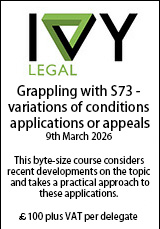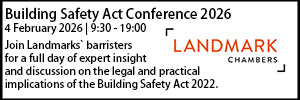The statutory duty under s.41 Highways Act 1980
- Details
Carol Cheng makes some observations on two different public liability cases alleging breach of statutory duty under s.41 Highways Act 1980 (Duty to maintain highways maintainable at public expense) which gave rise to different outcomes.
Applicable law
As a matter of law, the burden of proving the injury and the circumstances of the accident, including the nature of the defect, lies on the Claimant. However, the burden of proof for the special defence under s.58 Highways Act 1980 lies on the Defendant.
In terms of what a Claimant must prove in order to succeed against a highway authority in a claim for personal injury for failure to maintain or repair the highway, the case of Mills v Barnsley MBC [1992] PIQR P291 at 293 summarised the principles as follows:
(a) the highway was in such a condition that it was dangerous to traffic or pedestrians in the sense that, in the ordinary course of human affairs, danger may reasonably have been anticipated from its continued use by the public;
(b) the dangerous condition was created by the failure to maintain or repair the highway; and
(c) the injury or damage resulted from such a failure.
The court further held at 294 that the test of dangerousness is one of reasonable foresight of harm to users of the highway.
Where the alleged danger is the presence of water which had accumulated on the surface of the highway apparently as a result of blocked highway drains, the case of Mott MacDonald v Dept TER [2006] EWCA Civ 1089 held at [53] that occasional flooding at any time is not in itself evidence of a failure to maintain the highway.
First case
In the first case, the claim was one of public liability where the alleged defect was a broken and raised paving slab which the Claimant tripped over and suffered personal injury as a result. The Claimant alleged a breach of statutory duty for failure to discharge the duty to maintain the highway under s.41 Highways Act 1980.
The Defendant conceded that there was an actionable defect and therefore the issue before the court was whether a special defence under s.58 Highways Act 1980 was made out.
The Defendant was unsuccessful in establishing a s.58 defence as its defence relied upon its having acted in accordance with its inspection policy, which it was unable to prove. Specifically, the evidence of the Defendant witness highways inspector was that inspections were in practice carried out three times per annum; however, this was not supported by the Well Managed Highway Infrastructure Guidance Document which was unclear as to the prescribed number of inspections per annum for that particular highway, and was further contradicted by a letter from the Defendant which stated that the accident location was the subject of monthly inspections. In the circumstances, liability was found in favour of the Claimant.
Second case
In the second case, the Claimant alleged a breach of statutory duty under s.41 Highways Act 1980 for failure to remedy a trench and pot hole and failure to provide adequate drainage system on a highway which resulted in a motorbike accident causing personal injury.
In this case, the Defendant disputed that there was an actionable defect. The Judge found liability in favour of the Defendant on the basis that there was no finding of dangerousness in use of the highway. This conclusion was reached in light of the following findings: (i) the trench and pot hole were located on the verge as opposed to the main highway and did not meet the relevant threshold for investigation; and (ii) there was no evidence of more than occasional flooding which in itself does not lead to a dangerous condition (Mott).
In the alternative, the Defendant sought to rely on the special defence under s.58 Highways Act 1980.The Judge found that the s.58 defence was made out since (i) the road is subject to quarterly inspections, (ii) there were no complaints about road quality made by other members of the public, and (iii) there was no evidence of depth of defect or visible verge erosion.
Observations
When deciding whether to bring a claim, claimants should seek to obtain a copy of the relevant highways guidance document (e.g. Well Managed Highway Infrastructure Guidance Document, or the Maintenance and Inspections Strategy document) in order to ascertain the requisite threshold for inspections and/or repairs, so as to determine whether there is a viable case for alleging a defect.
Claimants should also seek to obtain contemporaneous evidence of the alleged defect, for example by way of photographs and clear measurements taken as close to the accident date as possible, so as to prevent the Defendant from arguing that the defect may have altered or deteriorated in the intervening period.
Carol Cheng is a barrister at Pump Court Chambers.
Sponsored articles
Unlocking legal talent
Walker Morris supports Tower Hamlets Council in first known Remediation Contribution Order application issued by local authority
Contracts Lawyer
Principal Lawyer - Planning, Property & Contract
Legal Director - Government and Public Sector
Lawyer (Planning and Regulatory)
Senior Lawyer - Planning, Property & Contracts Team
Locums
Poll
20-01-2026 5:00 pm
03-02-2026 2:00 pm
12-02-2026 10:00 am









































